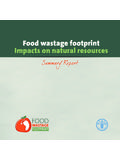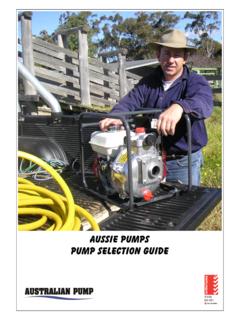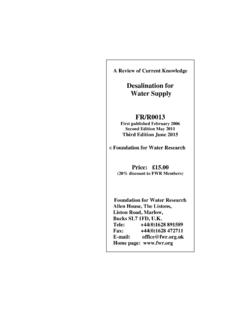Transcription of Supporting Document 3 - Waste Management
1 Supporting Document 3. Leachate Treatment Alternatives . Assessment and Evaluation Methodology Waste Management of Canada Corporation West Carleton Environmental Centre Landfill footprint Expansion LEACHATE TREATMENT ALTERNATIVES . ASSESSMENT AND EVALUATION. METHODOLOGY. Prepared by: AECOM Canada Ltd. Project Number: 60242342. Date: August, 2012. Leachate Treatment Alternatives Assessment and Evaluation Methodology West Carleton Environmental Centre Table of Contents Page 1. Overview of Leachate Treatment Alternatives .. 1. 1. Report Objective .. 1. 2. Considerations for Leachate Treatment Alternatives .. 2. Leachate 2. Leachate Generation Rate .. 2. Leachate Quality .. 3. Leachate Pretreatment .. 5. Equalization .. 5. Biological Treatment .. 6. Chemical Treatment .. 7. Filtration .. 8. Reverse Osmosis .. 8. Granular Activated Carbon Adsorption .. 8. 3. Description of Leachate Treatment Alternatives .. 9. On-site Tree Irrigation .. 10. Feasibility and Reliability.
2 11. Regulatory Considerations .. 11. Environmental Considerations .. 11. Capital and Operating 12. On-site Leachate Evaporation .. 12. Feasibility and Reliability .. 13. Regulatory Considerations .. 14. Environmental Considerations .. 14. Capital and Operating 14. Off-site Effluent Discharge to Surface Water .. 14. Feasibility and Reliability .. 16. Regulatory Considerations .. 16. Environmental Considerations .. 17. Capital and Operating 17. Off-site Effluent Discharge to City of Ottawa Sanitary Sewer .. 17. Feasibility and Reliability .. 18. Regulatory Considerations .. 18. Environmental Considerations .. 18. Capital and Operating 18. Truck Haulage Off-site to Alternative Wastewater Treatment Plant .. 19. Feasibility and Reliability .. 19. Regulatory Considerations .. 20. Environmental Considerations .. 20. Leachate Treatment Alternatives Assessment and Evaluation Methodology West Carleton Environmental Centre Capital and Operating 20. 4. Evaluation of Leachate Treatment Alternatives.
3 21. Evaluation Methodology .. 21. Evaluation Results .. 22. Option #1 On-site Tree Irrigation .. 22. Option #2 On-site Leachate Evaporation .. 29. Option #3 Off-site Effluent Discharge to Surface Water .. 29. Option #4 Off-site Effluent Discharge to City of Ottawa Sanitary Sewer .. 29. Option #5 Truck Haulage Off-site to Alternative Wastewater Treatment Plant .. 30. Comparative Evaluation of Leachate Treatment Alternatives .. 30. Overall Ranking .. 30. Sensitivity Analysis .. 30. Preferred Alternative .. 33. List of Figures Figure 1. Preferred Landfill footprint and Surrounding Area Figure 2. On-site Tree Irrigation Figure 3. On-site Leachate Evaporation Figure 4. Off-site Effluent Discharge to Surface Water Figure 5. Off-site Effluent Discharge to City of Ottawa Sanitary Sewer Figure 6. Truck Haulage Off-site to Alternative Wastewater Treatment Plant List of Tables Table 1. Raw Leachate Characteristics, Conventional and Other Frequently Monitored Parameters at the Existing Ottawa WMF.
4 4. Table 2. Raw Leachate Characteristics at the Existing Ottawa WMF, January 2010. Comprehensive 4. Table 3. Estimated Air Emissions*, On-Site Evaporator Treatment .. 13. Table 4. Comparative Evaluation of Leachate Treatment Alternatives .. 23. Appendices Appendix A. Facility Sizing Calculations Leachate Treatment Alternatives Assessment and Evaluation Methodology West Carleton Environmental Centre 1. Overview of Leachate Treatment Alternatives Background Waste Management of Canada Corporation (WM) is preparing an Environmental Assessment (EA) for a proposed undertaking consisting of the provision of a new landfill footprint at the existing Ottawa Waste Management Facility (Ottawa WMF). The new landfill footprint will be one component of the proposed West Carleton Environmental Centre (WCEC). The existing Ottawa WMF landfill is located on Lots 3 and 4, Concession 3 in the former Township of Huntley, formerly in the Township of West Carleton, now the City of Ottawa near the intersection of Carp Road and Highway 417.
5 WM has undertaken and received approval of a Terms of Reference (ToR) to carry out an EA. intended to identify and assess a new landfill footprint as part of the WCEC. During the formal review of the proposed ToR for an Environmental Assessment of a New Landfill footprint at the West Carleton Environmental Centre, a number of comments were received from various government agencies and the public. Specifically, the City of Ottawa and the Ministry of Environment (MOE) requested that WM consider alternative methods for treating and disposing of leachate generated from the new landfill footprint . In response to this request, WM. amended the proposed ToR to reflect that leachate treatment alternatives would be considered and assessed as part of the EA. A preferred leachate treatment alternative will be identified following the identification of the preferred landfill footprint alternative (Option 2). The location of the preferred landfill footprint and surrounding area is shown in Figure 1.
6 Report Objective This Document presents background information on the requirement to collect and control leachate, projected leachate volumes and quality, a description of the proposed leachate treatment alternatives, a qualitative assessment of the alternatives, and identification of a preferred approach to leachate disposal for the new landfill footprint . The leachate treatment alternatives have been described to a conceptual level of detail to enable a comparative analysis. The descriptions have focused on identifying characteristics that could be used to differentiate the alternatives from one another. The preferred leachate treatment alternative will be described in further detail as part of the detailed impact assessment of the undertaking. 1. Leachate Treatment Alternatives Assessment and Evaluation Methodology West Carleton Environmental Centre 2. Considerations for Leachate Treatment Alternatives Leachate Control The landfill leachate collection and treatment system for the new landfill footprint must be designed in accordance with the requirements of Ontario Regulation 232/98 ( 232/98).
7 In addition, the MOE's Reasonable Use Guideline B-7 must be met. The Reasonable Use Guideline sets limits for the allowable concentrations of contaminants based on background groundwater quality and the reasonable use of groundwater on adjacent property. The limits are set such that there would not be any significant effect on the use of groundwater on the adjacent property. 232/98 allows for two approaches to designing a landfill to protect groundwater quality a site specific design, or a generic design. The site specific approach allows a proponent to design the leachate controls to suit the site setting provided that the Reasonable Use limits are met. The generic approach allows the proponent to select one of two generic designs which have been developed such that the Reasonable Use limits are met within a broad range of hydrogeologic settings. At this time WM is planning to design the new landfill footprint with the Generic II Double Liner system as specified in the 232/98.
8 This consists of (from top down): m thick granular/perforated pipe primary leachate collection system;. m thick geomembrane/engineered clay primary liner;. m thick granular/perforated pipe secondary leachate collection system;. m thick geomembrane/engineered clay secondary liner;. 1 m thick natural or constructed soil attenuation layer. The raw leachate collected within the landfill will be pumped from the primary drainage/leachate collection system. The potential location and size of leachate pumping station(s) required will be identified as part of the conceptual design for the preferred landfill footprint . Leachate will then be directed to treatment facilities in a manner dependent on the preferred leachate treatment alternative. Leachate Generation Rate The quantity and rate at which leachate is generated from the landfill are expected to be important factors in assessing the ability of a specific treatment alternative to manage the leachate on an ongoing basis.
9 The volume of leachate to be managed will vary over the operational and post- closure period of the landfill and is influenced by factors including precipitation, degree of landfill 2. Leachate Treatment Alternatives Assessment and Evaluation Methodology West Carleton Environmental Centre development ( , area of landfill that is actively undergoing development versus areas where final cover has been placed), final cover design and cover installation progress, and other factors. For the purposes of describing the proposed leachate treatment alternatives, a series of leachate generation rates has been calculated based on the following: Leachate generation rates vary according to the size of the landfill footprint and the preferred landfill footprint area is approximately 36 ha;. Increased volumes of leachate will be generated during the operating period for the landfill based upon the area of Waste without final cover. The volume of leachate generated will decrease when the landfill footprint is fully closed.
10 The final cover design is reflective of the minimum design specified in 232/98, consisting of m of compacted fine-grained soil overlain by a m thick vegetative layer in order to limit infiltration to 150 mm/year; and, Leachate generation rates for the preferred landfill footprint were estimated using the Hydrologic Evaluation of Landfill Performance (HELP) model for predicting hydrologic processes, testing the effectiveness of landfill designs, and assigning groundwater recharge rates. Additional information regarding the HELP modeling can be found in the Facility Characteristics Report (FCR). for the preferred landfill footprint alternative. The FCR is included as Supporting Document 4 to this EA. Leachate generation rates during the landfill operating period will vary and will be higher than in the closed state. The approximate maximum leachate generation rate (expressed as an annual average) during the landfill operating period is estimated to be litres per second (L/s).








